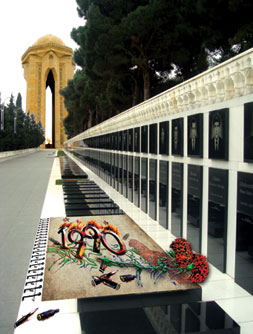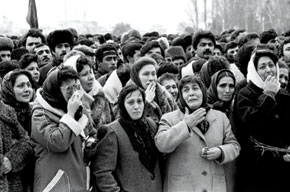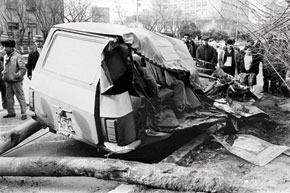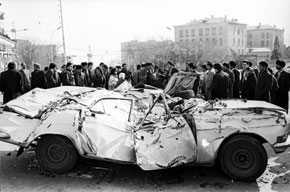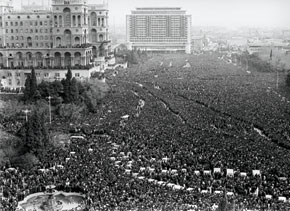Pages 22-27
by Ibrahim Zeynalov
Causes
Although 21 years have elapsed since the events of 20 January and various views have been expressed on the reasons for the tragedy, all opinions have one common feature: the people of Azerbaijan demonstrated to the world at the turn of the 20th century that they would not deviate from their pursuit of freedom and independence.
The trail leading to 20 January opened in the 1980s. The Azerbaijani people’s struggle to preserve the territorial integrity of their country began in 1988 and eventually developed into a national liberation movement.
The failure of the USSR government to forestall renewed Armenian claims on Azerbaijan’s territory, and separatist activities in Nagorno-Karabakh, further bolstered the people’s national liberation spirit.
The leaders of the Soviet empire perpetrated the 20 January massacre in Azerbaijan, a republic with strengthening tendencies towards independence, in order “to teach a lesson” to other Turkic-speaking nations of the USSR.
Various state-of-the-art items of Soviet military hardware and personnel were deployed around Baku in mid-January 1990. The Presidium of the USSR Supreme Council resolved on 19 January 1990 to introduce a state of emergency in Baku as of 20:00 on 20 January 1990, but the decision was kept secret in order to trap those who had taken to the streets to defend their constitutional rights and massacre them. A prior announcement of the state of emergency and curfew could have disrupted the USSR leadership’s plans.
The Baku operation and its consequences
The Baku operation was overseen personally by the USSR’s Minister of Defence. It was carried out by specifically trained units of the Soviet army against their own people. The most sophisticated military hardware and equipment, tear gas and various types of arms and ammunition were used in the operation.
Unarmed people who tried to find shelter to hide from the sporadic gunfire were picked out by spotlight and fired at. This is how many innocent civilians, including the elderly, women, children - anyone who happened to be on the street - were killed. Armed detachments of the Soviet army even resorted to firing on people from tanks and armoured personnel carriers. Soldiers fired on ambulance teams coming from hospitals to provide first aid to those wounded or to recover the bodies of the dead.
As a result of the special operation conducted by the Soviet army in Baku and other parts of the republic, a total of 137 people were killed on 20 January 1990, including more than 120 Azerbaijanis, six Russians, three Jews, three Tatars. A total of 744 people were wounded, 400 people were arrested and four were reported missing. Those killed ranged in age from 12 and 73.
On 21 January, Heydar Aliyev, who was living in Moscow at the time, went to Azerbaijan’s permanent representative office in the Soviet capital, flatly condemned the crime perpetrated by the USSR leaders against Azerbaijan and its citizens, and expressed support for his people. In a statement made at the meeting, Heydar Aliyev gave a political assessment of the tragedy:
As far as the developments in Azerbaijan are concerned, I am convinced that they run counter to the rule of law, democracy, humanity and the principles of state building in our country.
International attitude
Shortly after these events, heads of state and government of Western countries issued biased and lopsided statements without bothering to examine their historical and political background.
It is also worth mentioning that from the latter half of the 1980s, the West and other parts of the world were receiving only distorted information about Azerbaijan. This anti-Azerbaijan campaign was spearheaded by the central Soviet media. Another major contributor was the powerful Armenian lobby operating in many countries.
Even in the aftermath of the massacre, leaders of the western superpowers did nothing to establish what had actually happened in Baku and expose those who had masterminded developments. Instead, they fully supported the destructive policies of the USSR leadership, headed by Mikhail Gorbachev, which would inevitably lead to a break-up of the Soviet Union. They even provided indirect support for one of Gorbachev’s key policies, that of ethnic conflict. Western leaders knew only too well that support for chauvinist policies against the Turkic-speaking nations of the USSR would speed up the collapse of the Soviet empire.
Analyses show that the key reason behind Western support for Gorbachev’s policies was that the conflicts were playing into the hands of the USSR’s ‘cold war’ enemies and served their strategic interests. The Caucasus, including Azerbaijan, did not register in Western geopolitical interests at the time.
According to Zbigniew Brzezinski, a former US presidential security adviser, the US administration made a serious mistake in underestimating the strategic importance of the Caucasus and leaving it beyond its sphere of interest in the late 1980s and early 1990s. For this reason, the US State Department’s assessment of events was totally misconceived. A spokesman for the State Department said in a statement that Washington did not support Azerbaijan on the 20 January developments and did not want to provide a comment on the situation.
The foreign ministries of the UK and Italy issued statements indicating that the developments in Baku were “an internal affair of the USSR”. The statements said further that the Soviet government had carried out the Baku operation in order to restore stability and prevent ethnic confrontation.
At the same time, leaders of Turkey, Pakistan, Uzbekistan, Kazakhstan, Arab world countries, Iran and a number of international organizations, including the Istanbul-based Eurasia Foundation, said that the massacre unleashed by the Soviet Union against civilians in Baku could not reverse the Azerbaijani people’s struggle for freedom and independence, adding that those killed on that horrific night had entered the history of the Turkic world.
While describing the 20 January developments in Baku as a tragedy, the statements of support indicated that they would also be remembered as days of great hope, belief and victory. Although the Soviet Union crushed protesters ruthlessly and did everything in its power to silence their voices, it failed to achieve its goal.
The Soviet leadership, with significant assistance from its media, attempted to conceal the actual causes and aims of the 20 January operation in Baku and even succeed in convincing some Western circles of the ‘reasonable’ nature of its policies. As a result, no international condemnation or sanctions followed from that anti-constitutional campaign in Azerbaijan.
Lessons learned
The USSR government chose to slaughter those who had risen to defend their territorial integrity and protest against the policies of the centre. The deployment of a large contingent of special-purpose units and USSR Interior Troops in the Baku operation led to unprecedented cruelty and the killing of innocent civilians.
The Baku operation, which was intended to break the will of the Azerbaijani people and display the full strength of the Soviet military machine, was an act of pure aggression.
One of the bloodiest crimes committed by the Communist regime in the 20th century, this was an act of aggression not only against Azerbaijan, but also against all mankind. Unfortunately, those who are culpable got away with it.
It is beyond doubt that, along with the Soviet leadership, the then Azerbaijani administration has to share the blame for what happened. Analysis of the events shows that the Azerbaijani leadership of the day ignored people’s demands and followed orders from Moscow without reckoning that the situation might get out of hand.
The Baku tragedy exposed the deep gap between the people and government in Azerbaijan. It demonstrated that Azerbaijan needed a strong, wise and subtle leadership with great respect for national values, a leadership experienced and capable of leading the nation forward without shedding blood and offering up sacrifice.
After 20 January 1990, Azerbaijan entered upon a new phase in its struggle for freedom, independence and territorial integrity. It was on this date that many patriots decided that the honour and dignity of their nation and their people’s freedom are above all else and they made the ultimate sacrifice.
The Soviet leaders failed to break the will of the Azerbaijani people. On the contrary, the nation became even more united around the idea of independence.
The tragedy showed again that the empire was destined to fall apart. Azerbaijan’s path to independence and sovereignty lay through secession from the empire and restoration of the independence the republic had lost in 1920. From this standpoint, 20 January must be seen as a watershed in the history of Azerbaijan. It also turned the national liberation movement in Azerbaijan into a political reality.
About the author: Ibrahim Zeynalov is a Doctor of History, Professor of the Chair of History at Baku State University. He has conducted research and authored a number of monographs on the modern history of Azerbaijan.
by Ibrahim Zeynalov
Causes
Although 21 years have elapsed since the events of 20 January and various views have been expressed on the reasons for the tragedy, all opinions have one common feature: the people of Azerbaijan demonstrated to the world at the turn of the 20th century that they would not deviate from their pursuit of freedom and independence.
The trail leading to 20 January opened in the 1980s. The Azerbaijani people’s struggle to preserve the territorial integrity of their country began in 1988 and eventually developed into a national liberation movement.
The failure of the USSR government to forestall renewed Armenian claims on Azerbaijan’s territory, and separatist activities in Nagorno-Karabakh, further bolstered the people’s national liberation spirit.
The leaders of the Soviet empire perpetrated the 20 January massacre in Azerbaijan, a republic with strengthening tendencies towards independence, in order “to teach a lesson” to other Turkic-speaking nations of the USSR.
Various state-of-the-art items of Soviet military hardware and personnel were deployed around Baku in mid-January 1990. The Presidium of the USSR Supreme Council resolved on 19 January 1990 to introduce a state of emergency in Baku as of 20:00 on 20 January 1990, but the decision was kept secret in order to trap those who had taken to the streets to defend their constitutional rights and massacre them. A prior announcement of the state of emergency and curfew could have disrupted the USSR leadership’s plans.
The Baku operation and its consequences
The Baku operation was overseen personally by the USSR’s Minister of Defence. It was carried out by specifically trained units of the Soviet army against their own people. The most sophisticated military hardware and equipment, tear gas and various types of arms and ammunition were used in the operation.
Unarmed people who tried to find shelter to hide from the sporadic gunfire were picked out by spotlight and fired at. This is how many innocent civilians, including the elderly, women, children - anyone who happened to be on the street - were killed. Armed detachments of the Soviet army even resorted to firing on people from tanks and armoured personnel carriers. Soldiers fired on ambulance teams coming from hospitals to provide first aid to those wounded or to recover the bodies of the dead.
As a result of the special operation conducted by the Soviet army in Baku and other parts of the republic, a total of 137 people were killed on 20 January 1990, including more than 120 Azerbaijanis, six Russians, three Jews, three Tatars. A total of 744 people were wounded, 400 people were arrested and four were reported missing. Those killed ranged in age from 12 and 73.
On 21 January, Heydar Aliyev, who was living in Moscow at the time, went to Azerbaijan’s permanent representative office in the Soviet capital, flatly condemned the crime perpetrated by the USSR leaders against Azerbaijan and its citizens, and expressed support for his people. In a statement made at the meeting, Heydar Aliyev gave a political assessment of the tragedy:
As far as the developments in Azerbaijan are concerned, I am convinced that they run counter to the rule of law, democracy, humanity and the principles of state building in our country.
International attitude
Shortly after these events, heads of state and government of Western countries issued biased and lopsided statements without bothering to examine their historical and political background.
It is also worth mentioning that from the latter half of the 1980s, the West and other parts of the world were receiving only distorted information about Azerbaijan. This anti-Azerbaijan campaign was spearheaded by the central Soviet media. Another major contributor was the powerful Armenian lobby operating in many countries.
Even in the aftermath of the massacre, leaders of the western superpowers did nothing to establish what had actually happened in Baku and expose those who had masterminded developments. Instead, they fully supported the destructive policies of the USSR leadership, headed by Mikhail Gorbachev, which would inevitably lead to a break-up of the Soviet Union. They even provided indirect support for one of Gorbachev’s key policies, that of ethnic conflict. Western leaders knew only too well that support for chauvinist policies against the Turkic-speaking nations of the USSR would speed up the collapse of the Soviet empire.
Analyses show that the key reason behind Western support for Gorbachev’s policies was that the conflicts were playing into the hands of the USSR’s ‘cold war’ enemies and served their strategic interests. The Caucasus, including Azerbaijan, did not register in Western geopolitical interests at the time.
According to Zbigniew Brzezinski, a former US presidential security adviser, the US administration made a serious mistake in underestimating the strategic importance of the Caucasus and leaving it beyond its sphere of interest in the late 1980s and early 1990s. For this reason, the US State Department’s assessment of events was totally misconceived. A spokesman for the State Department said in a statement that Washington did not support Azerbaijan on the 20 January developments and did not want to provide a comment on the situation.
The foreign ministries of the UK and Italy issued statements indicating that the developments in Baku were “an internal affair of the USSR”. The statements said further that the Soviet government had carried out the Baku operation in order to restore stability and prevent ethnic confrontation.
At the same time, leaders of Turkey, Pakistan, Uzbekistan, Kazakhstan, Arab world countries, Iran and a number of international organizations, including the Istanbul-based Eurasia Foundation, said that the massacre unleashed by the Soviet Union against civilians in Baku could not reverse the Azerbaijani people’s struggle for freedom and independence, adding that those killed on that horrific night had entered the history of the Turkic world.
While describing the 20 January developments in Baku as a tragedy, the statements of support indicated that they would also be remembered as days of great hope, belief and victory. Although the Soviet Union crushed protesters ruthlessly and did everything in its power to silence their voices, it failed to achieve its goal.
The Soviet leadership, with significant assistance from its media, attempted to conceal the actual causes and aims of the 20 January operation in Baku and even succeed in convincing some Western circles of the ‘reasonable’ nature of its policies. As a result, no international condemnation or sanctions followed from that anti-constitutional campaign in Azerbaijan.
Lessons learned
The USSR government chose to slaughter those who had risen to defend their territorial integrity and protest against the policies of the centre. The deployment of a large contingent of special-purpose units and USSR Interior Troops in the Baku operation led to unprecedented cruelty and the killing of innocent civilians.
The Baku operation, which was intended to break the will of the Azerbaijani people and display the full strength of the Soviet military machine, was an act of pure aggression.
One of the bloodiest crimes committed by the Communist regime in the 20th century, this was an act of aggression not only against Azerbaijan, but also against all mankind. Unfortunately, those who are culpable got away with it.
It is beyond doubt that, along with the Soviet leadership, the then Azerbaijani administration has to share the blame for what happened. Analysis of the events shows that the Azerbaijani leadership of the day ignored people’s demands and followed orders from Moscow without reckoning that the situation might get out of hand.
The Baku tragedy exposed the deep gap between the people and government in Azerbaijan. It demonstrated that Azerbaijan needed a strong, wise and subtle leadership with great respect for national values, a leadership experienced and capable of leading the nation forward without shedding blood and offering up sacrifice.
After 20 January 1990, Azerbaijan entered upon a new phase in its struggle for freedom, independence and territorial integrity. It was on this date that many patriots decided that the honour and dignity of their nation and their people’s freedom are above all else and they made the ultimate sacrifice.
The Soviet leaders failed to break the will of the Azerbaijani people. On the contrary, the nation became even more united around the idea of independence.
The tragedy showed again that the empire was destined to fall apart. Azerbaijan’s path to independence and sovereignty lay through secession from the empire and restoration of the independence the republic had lost in 1920. From this standpoint, 20 January must be seen as a watershed in the history of Azerbaijan. It also turned the national liberation movement in Azerbaijan into a political reality.
About the author: Ibrahim Zeynalov is a Doctor of History, Professor of the Chair of History at Baku State University. He has conducted research and authored a number of monographs on the modern history of Azerbaijan.
